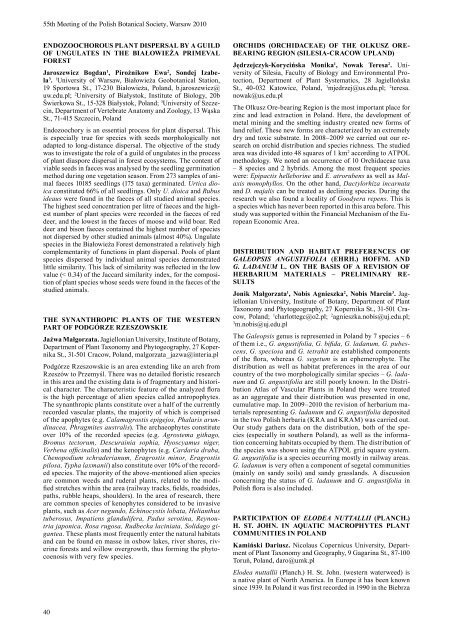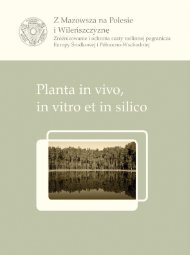acta societatis botanicorum poloniae - LV Zjazd Polskiego ...
acta societatis botanicorum poloniae - LV Zjazd Polskiego ...
acta societatis botanicorum poloniae - LV Zjazd Polskiego ...
You also want an ePaper? Increase the reach of your titles
YUMPU automatically turns print PDFs into web optimized ePapers that Google loves.
55th Meeting of the Polish Botanical Society, Warsaw 2010<br />
ENdOZOOCHOrOUS PLANT dISPErSAL BY A GUILd<br />
of UNGULAtES IN tHE BIAŁoWIEżA PRIMEvAL<br />
FOrEST<br />
Jaroszewicz Bogdan 1 , Pirożnikow Ewa 2 , Sondej Izabela<br />
3 . 1 University of Warsaw, Białowieża Geobotanical Station,<br />
19 Sportowa St., 17-230 Białowieża, Poland, b.jaroszewicz@<br />
uw.edu.pl; 2 University of Białystok, Institute of Biology, 20b<br />
Świerkowa St., 15-328 Białystok, Poland; 3 University of Szczecin,<br />
Department of Vertebrate Anatomy and Zoology, 13 Wąska<br />
St., 71-415 Szczecin, Poland<br />
Endozoochory is an essential process for plant dispersal. This<br />
is especially true for species with seeds morphologically not<br />
adapted to long-distance dispersal. The objective of the study<br />
was to investigate the role of a guild of ungulates in the process<br />
of plant diaspore dispersal in forest ecosystems. The content of<br />
viable seeds in faeces was analysed by the seedling germination<br />
method during one vegetation season. From 273 samples of animal<br />
faeces 10185 seedlings (175 taxa) germinated. Urtica dioica<br />
constituted 66% of all seedlings. Only U. dioica and Rubus<br />
ideaus were found in the faeces of all studied animal species.<br />
The highest seed concentration per litre of faeces and the highest<br />
number of plant species were recorded in the faeces of red<br />
deer, and the lowest in the faeces of moose and wild boar. Red<br />
deer and bison faeces contained the highest number of species<br />
not dispersed by other studied animals (almost 40%). Ungulate<br />
species in the Białowieża Forest demonstrated a relatively high<br />
complementarity of functions in plant dispersal. Pools of plant<br />
species dispersed by individual animal species demonstrated<br />
little similarity. This lack of similarity was reflected in the low<br />
value (< 0.34) of the Jaccard similarity index, for the composition<br />
of plant species whose seeds were found in the faeces of the<br />
studied animals.<br />
THE SYNANTHrOPIC PLANTS OF THE WESTErN<br />
PARt of PoDGóRZE RZESZoWSKIE<br />
Jaźwa Małgorzata. Jagiellonian University, Institute of Botany,<br />
Department of Plant Taxonomy and Phytogeography, 27 Kopernika<br />
St., 31-501 Cracow, Poland, malgorzata_jazwa@interia.pl<br />
Podgórze Rzeszowskie is an area extending like an arch from<br />
Rzeszów to Przemyśl. There was no detailed floristic research<br />
in this area and the existing data is of fragmentary and historical<br />
character. The characteristic feature of the analyzed flora<br />
is the high percentage of alien species called antropophytes.<br />
The synanthropic plants constitute over a half of the currently<br />
recorded vascular plants, the majority of which is comprised<br />
of the apophytes (e.g. Calamagrostis epigejos, Phalaris arundinacea,<br />
Phragmites australis). The archaeophytes constitute<br />
over 10% of the recorded species (e.g. Agrostema githago,<br />
Bromus tectorum, Descurainia sophia, Hyoscyamus niger,<br />
Verbena officinalis) and the kenophytes (e.g. Cardaria draba,<br />
Chenopodium schraderianum, Eragrostis minor, Eragrostis<br />
pilosa, Typha laxmanii) also constitute over 10% of the recorded<br />
species. The majority of the above-mentioned alien species<br />
are common weeds and ruderal plants, related to the modified<br />
stretches within the area (railway tracks, fields, roadsides,<br />
paths, rubble heaps, shoulders). In the area of research, there<br />
are common species of kenophytes considered to be invasive<br />
plants, such as Acer negundo, Echinocystis lobata, Helianthus<br />
tuberosus, Impatiens glandulifera, Padus serotina, Reynoutria<br />
japonica, Rosa rugosa, Rudbecka laciniata, Solidago gigantea.<br />
These plants most frequently enter the natural habitats<br />
and can be found en masse in oxbow lakes, river shores, riverine<br />
forests and willow overgrowth, thus forming the phytocoenosis<br />
with very few species.<br />
40<br />
OrCHIdS (OrCHIdACEAE) OF THE OLKUSZ OrE-<br />
BEArING rEGION (SILESIA-CrACOW UPLANd)<br />
Jędrzejczyk-Korycińska Monika1 , Nowak Teresa2 . University<br />
of Silesia, Faculty of Biology and Environmental Protection,<br />
Department of Plant Systematics, 28 Jagiellońska<br />
St., 40-032 Katowice, Poland, 1mjedrzej@us.edu.pl; 2teresa. nowak@us.edu.pl<br />
The Olkusz Ore-bearing Region is the most important place for<br />
zinc and lead extraction in Poland. Here, the development of<br />
metal mining and the smelting industry created new forms of<br />
land relief. These new forms are characterized by an extremely<br />
dry and toxic substrate. In 2008– 2009 we carried out our research<br />
on orchid distribution and species richness. The studied<br />
area was divided into 48 squares of 1 km2 according to ATPOL<br />
methodology. We noted an occurrence of 10 Orchidaceae taxa<br />
– 8 species and 2 hybrids. Among the most frequent species<br />
were: Epipactis helleborine and E. atrorubens as well as Malaxis<br />
monophyllos. On the other hand, Dactylorhiza incarnata<br />
and D. majalis can be treated as declining species. During the<br />
research we also found a locality of Goodyera repens. This is<br />
a species which has never been reported in this area before. This<br />
study was supported within the Financial Mechanism of the European<br />
Economic Area.<br />
dISTrIBUTION ANd HABITAT PrEFErENCES OF<br />
GAleoPsis AnGustifoliA (EHrH.) HOFFM. ANd<br />
G. lAdAnum L. ON THE BASIS OF A rEVISION OF<br />
HErBArIUM MATErIALS – PrELIMINArY rE-<br />
SULTS<br />
Jonik Małgorzata1 , Nobis Agnieszka 2 , Nobis Marcin3 . Jagiellonian<br />
University, Institute of Botany, Department of Plant<br />
Taxonomy and Phytogeography, 27 Kopernika St., 31-501 Cracow,<br />
Poland; 1charlottegc@o2.pl; 2agnieszka.nobis@uj.edu.pl; 3m.nobis@uj.edu.pl The Galeopsis genus is represented in Poland by 7 species – 6<br />
of them i.e., G. angustifolia, G. bifida, G. ladanum, G. pubescens,<br />
G. speciosa and G. tetrahit are established components<br />
of the flora, whereas G. segetum is an ephemerophyte. The<br />
distribution as well as habitat preferences in the area of our<br />
country of the two morphologically similar species – G. ladanum<br />
and G. angustifolia are still poorly known. In the Distribution<br />
Atlas of Vascular Plants in Poland they were treated<br />
as an aggregate and their distribution was presented in one,<br />
cumulative map. In 2009– 2010 the revision of herbarium materials<br />
representing G. ladanum and G. angustifolia deposited<br />
in the two Polish herbaria (KRA and KRAM) was carried out.<br />
Our study gathers data on the distribution, both of the species<br />
(especially in southern Poland), as well as the information<br />
concerning habitats occupied by them. The distribution of<br />
the species was shown using the ATPOL grid square system.<br />
G. angustifolia is a species occurring mostly in railway areas.<br />
G. ladanum is very often a component of segetal communities<br />
(mainly on sandy soils) and sandy grasslands. A discussion<br />
concerning the status of G. ladanum and G. angustifolia in<br />
Polish flora is also included.<br />
PArTICIPATION OF elodeA nuttAllii (PLANCH.)<br />
H. ST. JOHN. IN AqUATIC MACrOPHYTES PLANT<br />
COMMUNITIES IN POLANd<br />
Kamiński Dariusz. Nicolaus Copernicus University, Department<br />
of Plant Taxonomy and Geography, 9 Gagarina St., 87-100<br />
Toruń, Poland, daro@umk.pl<br />
Elodea nuttallii (Planch.) H. St. John. (western waterweed) is<br />
a native plant of North America. In Europe it has been known<br />
since 1939. In Poland it was first recorded in 1990 in the Biebrza



